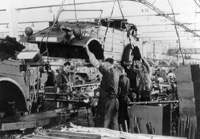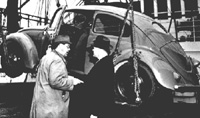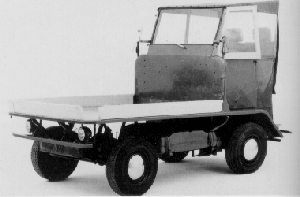
|
The early days The VW story started as a dream of Ferdinand Porsche. Porsche was a technical whiz kid, he made an electrical lighting system for his home town from scratch, before many the big cities had! He also designed electrical powered tanks for World War I and in the '20s designed race cars for some of the big German companies. The major car companies at the time were competing to hold the world speed record.
Porsche had a vision to build a car that everyone could afford. In Europe,
only the rich and famous could afford cars. In 1929, Porsche took his plans to his bosses at Daimler (which later became Mercedes), but they did not dare to market the car. Porsche left and he started his own design agency. | 
|
|
In 1932 He teamed up with Zündapp, a motorcycle manufacturer, to build 3 prototypes. The cars were basically Porsche's original design, but Zündapp requested the engine be a radial design 5 cylinder water cooled engine. Due to cooling problems the engines melted down after running for only ten minutes. Zündapp backed out and Porsche had to find a new partner. Next, Porsche linked up with NSU, another motorcycle manufacturer. They changed the engine into an air-cooled flat 4 (4 horizontally placed cylinders), which ran much better and on which the final engine was based. Due to the bad financial climate, NSU backed out and once again, Porsche had to find another new partner. | |
|
During this time Adolf Hitler started to gain power in Germany. While in jail during the 20s (for expressing his extreme political views) Hitler read Henry Fords biography and he also started to dream about a car for the common people. He felt it would be a good point for his election campaign. He was elected Reichskanzler (prime-minister) in 1933 , and his first speech was delivered at the Berlin Auto Show. When Porsche found out that Hitler shared his dream, he arranged a meeting with Hitler to find a business partner. |  Hitler & Porsche (on the right in suit) |
|
When they met, Hitler was very enthusiastic and he had some difficult demands:
The car had to be able to carry 2 adults and 3 children It should be able to cruise at 60 MPH/100 KMH on the autobahn (highway) It should have a fuel mileage of 33 MPG/1:7 LPK An air-cooled and very reliable motor (for the early morning starts commuters had to make) The car should also be able to carry 3 soldiers and a machine gun! The cost of the car should be under 1000 ReichsMark Between 1935 and 1937 there were about 50 prototypes built. During 1937 they were tested by the SS (Schuts Staffel, elite soldiers). The program lasted for about 1 million test miles. The design was made and the car was updated again. In 1938, 44 final prototypes were built, followed by 50 more for promotional reasons in 1939. The cornerstone of the factory was laid on May 26, 1938 by Hitler. Production was scheduled to begin in September 1939, but in march 1939 the war broke out. The people could save for a car by buying a 5 RM stamp every week, until they had saved enough or until there was a car available. But when the war broke out there were no cars being built. People kept saving but they never got a car. About 337,000 people had saved for a car, and the sum grew to 280 million RM. A lot of people think the money went to the war efforts, but after the war the Russian army found the money in a Berlin bank. The savers had to wait until 1961 to get 100 DM cash or a 600 DM discount on a new bug.
| |
|
The VW goes to war The war created a big demand for military vehicles. The Volkswagen factory was completely used for war production, but the round Beetle body was to difficult and costly to use on war vehicles. The Military needed a cheap and easy to build/repair vehicle. So the beetle chassis was cut to build a more square military convertible. The cars where called kübelwagens, and had slightly raised suspension for off road purposes. There was also an amphibic version of the Beetle called the schwimmwagen. It had a waterproof body and a propeller mounted on the crankshaft. During the war there were about 50.000 kübels and 15.000 schwimmwagens build. |  Front: Kubels on the production line Background: a Schwimmwagen |
|
The officers wanted a little more comfort and a special version of the beetle was built. It had a beetle-body and a kübel-pan, these cars were called type 82 or kommandeurwagens. Almost 600 of these cars were built.
The post war years | |
|
When the English came to Wolfsburg, which was called KDF-stadt back then, they appointed Major Ivan Hirst of the Royal Electrical and Mechanical Engineers as factory leader. The allied started a plan to remove all names that reminded of the Nazi regime. So KDF-Stadt became Wolfsburg (The castle on the hill next to the factory was called Schloß Wolfsburg). The English who were in charge of the area around Wolfsburg started to produce Beetles from the wreckage of the plant. Cars were a rare commodity and the allied needed vehicles to control Germany. They built some prototype cars from parts they found in the factory to show to the officers at head quarters. The officers were impressed and ordered 5000 saloons and the factory was saved. In 1948, the factory was given back to the German government and Major Hirst had to find a factory manager. He recruited Heinrich Nordhoff, who worked for Opel before the war. Heinrich's work at Opel prevented him from getting a job in the American sector. Nordhoff would prove to be pivotal for the factory's success. One of his accomplishments was the vision and implementation of a great dealer/service network.
There was a car dealer called Ben Pon in the neighbouring country Holland who had been intrested in selling beetles even before the war had started. In those first years the cars were exported to a few neighboring countries, but when on June, 20, 1948, Germany changed currencies (the RM was changed into the DM to stop inflation, the exchange rate was 10:1) and exports grew dramatically. England however, did not import many VWs until the late '50s, so strong was their anti German sentiment. In 1950, an Irish company started to assemble completely knocked down cars, this way the cars were manufactured in Ireland instead of Germany to get around an import ban on German products. The system proved to be successful and was expanded to South Africa (1951), Brazil (1953) and Australia (1955). Foreign production expanded to component parts as the German factories could not handle the demand. Soon, the cars became 100% home built. The number of plants expanded further to include a new Mexican plant, an expansion in Brazil and additional German plants.
| |
|
In 1949, the Dutch importer Ben Pon brought a Beetle to the USA, with poor
results. From 1951 a New York dealer sold some cars, but it was not until 1955, when VW of America was founded, that the US sales started to grow. The ad campaign, started in 1959 and designed by Doyle Dane and Berbach proved to be very succesfull. The campaign was off beat, modest and memorable.
|  Ben Pon (on the left) with the first VW ever |
|
The VW Bus Probably the best thing Pon did for VW was the invention of the bus !When he was at the factory in 1947 he saw a bug chassis with a big loading floor and a cabin above the engine. It was used to move parts inside the factory. The workers called it the Plattenwagen. These Plattenwagens were used until the 70's. When they got damaged they would be repared with newer parts. Thats the reason that the few Plattenwagens that are still around have lots of newer parts | 
|
|
When Pon was back in Holland he talked about importing it to Holland, but the position of the driver was unacceptable for the department of transportation. Pon started to think about a van based on the bugs chassis but with the driver up front. He made a drawing of his idea and at his next visit to the factory on April 23, 1947 he showed it to the manager of VWaG, who saw it's potential and in the fall of 1948 the first prototypes where built. The first prototypes used the normal bugs pan, but it had to be reinforced to take the extra load. Production started in February, 1950. | |
|
Other aircooled models In the late '60s world demand started to drop, and Volkswagen designed new cars based on the Beetles technique. Called the type 3 (as the transporter was type 2 ). In the early 1970s the new water-cooled models were introduced. This was the beginning of the end for the Beetle. In 1978, the last European built Beetles rolled of the assembly line and in 1980 the last convertible was made by Karmann. The Mexican and Brazilian plants remained in production for the South American market. Brazilian production was stopped for 7 years, but recently was restarted to provide the people with a cheap and reliable car.
| |